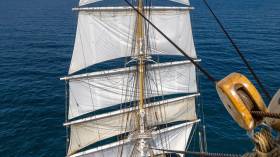Displaying items by tag: Norway's largest tallship
Norwegian Tallship Open to Visitors During Heritage Week
#HeritageVisitor - A Norwegian tall ship, Statsraad Lehmkuhl is calling to Dublin Port as part of Heritage Week, and will be open for visitors.
Statsraad Lehmkuhl will be docked at Sir John Rogerson’s Quay, where on Saturday 20 August, one of the world’s biggest tallships will be open to the public between 2 and 4pm. No booking is required nor no fee to gain admission on board what is also one of the oldest of the world’s square rigger ships.
Due to extensive conservation work over the last few decades, the Statsraad Lehmkuhl still looks almost as it did when it was completely new more than a hundred years ago, and a visit on the ship is therefore like taking a step back in time.
Statsraad Lehmkuhl will sail to Dublin from A Coruña, northern Spain where it recently became the winner of Tall Ship Races 2016. The ship will depart Dublin on Sunday 21. August and sail back home to Bergen, Norway, a journey that will take five days.
Statsraad Lehmkuhl was built in 1914, in Bremerhaven-Geestemünde in Germany, as a training ship for the German merchant marine.
In 1923, the ship was bought by “Det Bergenske Damskipsselskap” (Bergen Steamship Company), and renamed “Statsraad Lehmkuhl” (Minister Lemhkuhl) after the man responsible for securing it.
Statsraad Lehmkuhl was used as a training vessel for Bergen School Ship Foundation until 1967, except for a brief interval during World War II when it was confiscated by Germany.
Later on, the ship was donated to the Statsraad Lehmkuhl Foundation, which is the current owner and operator of the ship.
Over the years, the Foundation has arranged cruises and coastal trips that are open for the public to attend. In addition, Statsraad Lehmkuhl has often been rented out to schools, companies, clubs and organisations that have used the ship for shorter trips.
In recent years, Statsraad Lehmkuhl has become a familiar sight in the Bergen harbour, blending in seamlessly with the colourful wooden houses at “Bryggen”.























